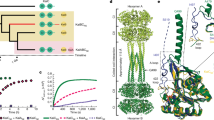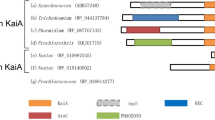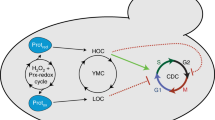Abstract
Circadian rhythms are ubiquitous in eukaryotes, and coordinate numerous aspects of behaviour, physiology and metabolism, from sleep/wake cycles in mammals to growth and photosynthesis in plants1,2. This daily timekeeping is thought to be driven by transcriptional–translational feedback loops, whereby rhythmic expression of ‘clock’ gene products regulates the expression of associated genes in approximately 24-hour cycles. The specific transcriptional components differ between phylogenetic kingdoms3. The unicellular pico-eukaryotic alga Ostreococcus tauri possesses a naturally minimized clock, which includes many features that are shared with plants, such as a central negative feedback loop that involves the morning-expressed CCA1 and evening-expressed TOC1 genes4. Given that recent observations in animals and plants have revealed prominent post-translational contributions to timekeeping5, a reappraisal of the transcriptional contribution to oscillator function is overdue. Here we show that non-transcriptional mechanisms are sufficient to sustain circadian timekeeping in the eukaryotic lineage, although they normally function in conjunction with transcriptional components. We identify oxidation of peroxiredoxin proteins as a transcription-independent rhythmic biomarker, which is also rhythmic in mammals6. Moreover we show that pharmacological modulators of the mammalian clock mechanism have the same effects on rhythms in Ostreococcus. Post-translational mechanisms, and at least one rhythmic marker, seem to be better conserved than transcriptional clock regulators. It is plausible that the oldest oscillator components are non-transcriptional in nature, as in cyanobacteria7, and are conserved across kingdoms.
This is a preview of subscription content, access via your institution
Access options
Subscribe to this journal
Receive 51 print issues and online access
$199.00 per year
only $3.90 per issue
Buy this article
- Purchase on Springer Link
- Instant access to full article PDF
Prices may be subject to local taxes which are calculated during checkout




Similar content being viewed by others
References
Harmer, S. L. The circadian system in higher plants. Annu. Rev. Plant Biol. 60, 357–377 (2009)
Reddy, A. B. & O’Neill, J. S. Healthy clocks, healthy body, healthy mind. Trends Cell. Biol. 20, 36–44 (2010)
Lakin-Thomas, P. L. Transcriptional feedback oscillators: maybe, maybe not. J. Biol. Rhythms 21, 83–92 (2006)
Corellou, F. et al. Clocks in the green lineage: Comparative functional analysis of the circadian architecture of the picoeukaryote Ostreococcus . Plant Cell 21, 3436–3449 (2009)
Hastings, M. H., Maywood, E. S. & O’Neill, J. S. Cellular circadian pacemaking and the role of cytosolic rhythms. Curr. Biol. 18, R805–R815 (2008)
Reddy, A. B. et al. Circadian orchestration of the hepatic proteome. Curr. Biol. 16, 1107–1115 (2006)
Nakajima, M. et al. Reconstitution of circadian oscillation of cyanobacterial KaiC phosphorylation in vitro . Science 308, 414–415 (2005)
Roenneberg, T. & Merrow, M. Circadian clocks—the fall and rise of physiology. Nature Rev. Mol. Cell Biol. 6, 965–971 (2005)
Ueda, H. R. Systems biology flowering in the plant clock field. Mol. Syst. Biol. 2, 60 (2006)
Mehra, A., Baker, C. L., Loros, J. J. & Dunlap, J. C. Post-translational modifications in circadian rhythms. Trends Biochem. Sci. 34, 483–490 (2009)
Merrow, M., Mazzotta, G., Chen, Z. & Roenneberg, T. The right place at the right time: regulation of daily timing by phosphorylation. Genes Dev. 20, 2629–2633 (2006)
O’Neill, J. S., Maywood, E. S., Chesham, J. E., Takahashi, J. S. & Hastings, M. H. cAMP-dependent signaling as a core component of the mammalian circadian pacemaker. Science 320, 949–953 (2008)
Woolum, J. C. A re-examination of the role of the nucleus in generating the circadian rhythm in Acetabularia. J. Biol. Rhythms 6, 129–136 (1991)
Morse, D. S., Fritz, L. & Hastings, J. W. What is the clock? Translational regulation of circadian bioluminescence. Trends Biochem. Sci. 15, 262–265 (1990)
Monnier, A. et al. Orchestrated transcription of biological processes in the marine picoeukaryote Ostreococcus exposed to light/dark cycles. BMC Genomics 11, 192 (2010)
Moulager, M. et al. Light-dependent regulation of cell division in Ostreococcus: evidence for a major transcriptional input. Plant Physiol. 144, 1360–1369 (2007)
Konopka, R. J. Genetic dissection of the Drosophila circadian system. Fed. Proc. 38, 2602–2605 (1979)
Hall, A., Karplus, P. A. & Poole, L. B. Typical 2-Cys peroxiredoxins–structures, mechanisms and functions. FEBS J. 276, 2469–2477 (2009)
Baier, M. & Dietz, K. J. The plant 2-Cys peroxiredoxin BAS1 is a nuclear-encoded chloroplast protein: its expressional regulation, phylogenetic origin, and implications for its specific physiological function in plants. Plant J. 12, 179–190 (1997)
O’Neill, J. S. & Reddy, A. B. Circadian clocks in human red blood cells. Nature doi:10.1038/nature09702 (this issue).
Khalsa, S. B., Whitmore, D., Bogart, B. & Block, G. D. Evidence for a central role of transcription in the timing mechanism of a circadian clock. Am. J. Physiol. 271, C1646–C1651 (1996)
Edwards, K. D. et al. FLOWERING LOCUS C mediates natural variation in the high-temperature response of the Arabidopsis circadian clock. Plant Cell 18, 639–650 (2006)
McClung, C. R. Plant circadian rhythms. Plant Cell 18, 792–803 (2006)
Dodd, A. N. et al. The Arabidopsis circadian clock incorporates a cADPR-based feedback loop. Science 318, 1789–1792 (2007)
Eide, E. J. et al. Control of mammalian circadian rhythm by CKIε-regulated proteasome-mediated PER2 degradation. Mol. Cell. Biol. 25, 2795–2807 (2005)
Hirota, T. et al. A chemical biology approach reveals period shortening of the mammalian circadian clock by specific inhibition of GSK-3β. Proc. Natl Acad. Sci. USA 105, 20746–20751 (2008)
Isojima, Y. et al. CKIε/δ-dependent phosphorylation is a temperature-insensitive, period-determining process in the mammalian circadian clock. Proc. Natl Acad. Sci. USA 106, 15744–15749 (2009)
Johnson, C. H., Mori, T. & Xu, Y. A cyanobacterial circadian clockwork. Curr. Biol. 18, R816–R825 (2008)
Eelderink-Chen, Z. et al. A circadian clock in Saccharomyces cerevisiae . Proc. Natl Acad. Sci. USA 107, 2043–2047 (2010)
Edwards, K. D. et al. Quantitative analysis of regulatory flexibility under changing environmental conditions. Mol. Syst. Biol. 6, 424 (2010)
Acknowledgements
CSBE is a Centre for Integrative Systems Biology funded by BBSRC and EPSRC award D019621. C.T. is supported by a BBSRC/ANR joint project F005466 awarded to F.-Y.B. and A.J.M. and by the HFSP. A.B.R. is supported by the Wellcome Trust (083643/Z/07/Z) and the MRC Centre for Obesity and Related metabolic Disorders (MRC CORD).
Author information
Authors and Affiliations
Contributions
J.S.O’N., G.v.O. and L.E.D. designed and performed the experiments; J.S.O’N., G.v.O., L.E.D., C.T., A.B.R. and A.J.M. analysed data. F.-Y.B. and F.C. generated essential protocols and biomaterials. All authors contributed to writing. J.S.O’N. and G.v.O. contributed equally to this paper.
Corresponding authors
Ethics declarations
Competing interests
The authors declare no competing financial interests.
Supplementary information
Supplementary Information
The file contains Supplementary Tables 1-2 and Supplementary Figures 1-6 with legends. (PDF 2660 kb)
Rights and permissions
About this article
Cite this article
O’Neill, J., van Ooijen, G., Dixon, L. et al. Circadian rhythms persist without transcription in a eukaryote. Nature 469, 554–558 (2011). https://doi.org/10.1038/nature09654
Received:
Accepted:
Published:
Issue Date:
DOI: https://doi.org/10.1038/nature09654
This article is cited by
-
Microbial circadian clocks: host-microbe interplay in diel cycles
BMC Microbiology (2023)
-
Immunological and inflammatory effects of infectious diseases in circadian rhythm disruption and future therapeutic directions
Molecular Biology Reports (2023)
-
Translational toxicology of metal(loid) species: linking their bioinorganic chemistry in the bloodstream to organ damage onset
BioMetals (2023)
-
Variations in Circadian Clock Organization & Function: A Journey from Ancient to Recent
Planta (2022)
-
Circadian Regulation and Clock-Controlled Mechanisms of Glycerophospholipid Metabolism from Neuronal Cells and Tissues to Fibroblasts
Molecular Neurobiology (2022)
Comments
By submitting a comment you agree to abide by our Terms and Community Guidelines. If you find something abusive or that does not comply with our terms or guidelines please flag it as inappropriate.



